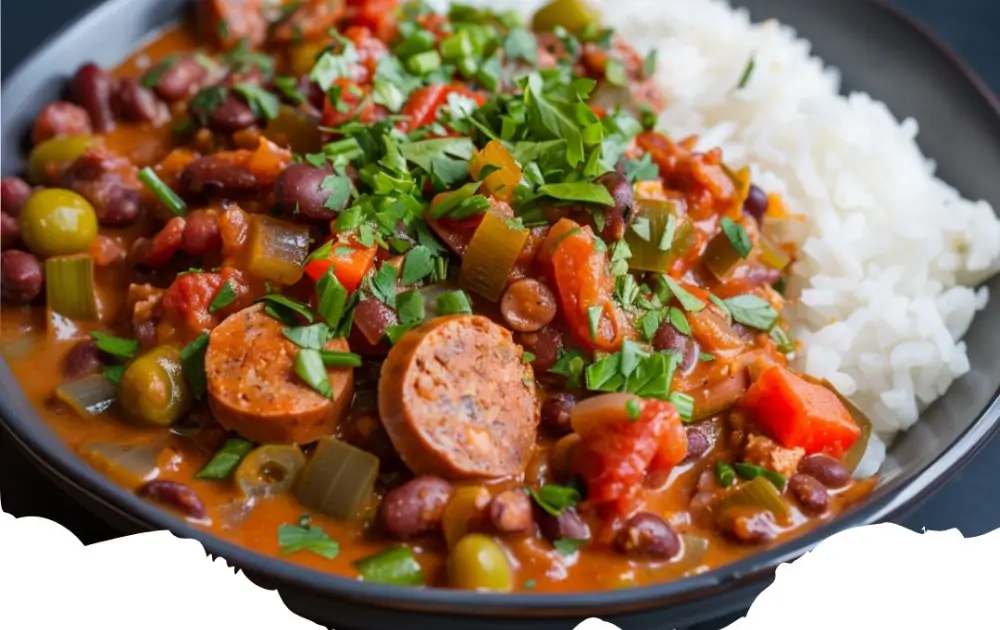Louisiana Red Beans and Rice is a quintessential dish deeply rooted in the culinary landscape of New Orleans. This hearty, flavorful meal combines tender red beans, spicy andouille sausage, and a medley of vegetables, all simmered to perfection and served over a bed of fluffy rice. Originating from Creole cuisine, it traditionally serves as a comfort food staple, particularly on Mondays, washing day, utilizing Sunday’s leftover ham.
Print
Louisiana Red Beans and Rice
- Total Time: 10 hours 30 minutes
- Yield: Serves 6-8 1x
- Diet: Vegetarian
Description
Louisiana Red Beans and Rice is a hearty, comforting dish steeped in New Orleans tradition. It features creamy red kidney beans, spicy andouille sausage, and the “holy trinity” of onion, celery, and bell pepper, all simmered together and served over a bed of fluffy white rice.
Ingredients
1 pound dry kidney beans
¼ cup olive oil
1 large onion, chopped
1 green bell pepper, chopped
2 stalks celery, chopped
2 tablespoons minced garlic
6 cups water
2 bay leaves
1 tablespoon dried parsley
1 teaspoon dried thyme
1 teaspoon Cajun seasoning
½ teaspoon cayenne pepper
¼ teaspoon dried sage
1 pound andouille sausage, sliced
4 cups water
2 cups long grain white rice
Instructions
Preparation:
Gather all ingredients.
Rinse beans, and then soak in a large pot of water overnight.
Cooking Vegetables:
Heat oil in a skillet over medium heat. Cook onion, bell pepper, celery, and garlic in olive oil for 3 to 4 minutes.
Preparing Beans:
Rinse beans, and transfer to a large pot with 6 cups water. Stir cooked vegetables into beans. Season with bay leaves, parsley, thyme, Cajun seasoning, cayenne pepper, and sage. Bring to a boil, and then reduce heat to medium-low. Simmer for 2 1/2 hours.
Adding Sausage:
Stir sausage into beans, and continue to simmer for 30 minutes.
Cooking Rice:
Meanwhile, prepare the rice. Bring water and rice to a boil in a saucepan. Reduce heat, cover, and simmer for 20 minutes.
Serving:
Serve beans over steamed white rice. Enjoy your Authentic Louisiana Red Beans and Rice! ![]()
Notes
- Soaking the beans reduces cooking time and aids digestion.
- For a spicier dish, increase the amount of cayenne pepper.
- This dish can be made vegetarian by omitting the sausage and using vegetable broth.
- Prep Time: 8 hours (includes soaking beans)
- Cook Time: 2 hours 30 minutes
- Category: Main Dish
- Method: Simmering
- Cuisine: Creole/Cajun
Nutrition
- Calories: 400 per serving (excluding rice)
- Sugar: 5g
- Sodium: 700mg
- Fat: 15g
- Carbohydrates: 40g
- Fiber: 10g
- Protein: 25g

FAQs About Louisiana Red Beans and Rice
Can I use canned beans instead of dried? Yes, you can use canned red kidney beans for convenience. Rinse and drain them before adding to the pot, and reduce the cooking time since they are already soft.
What can I use if I don’t have andouille sausage? If andouille sausage is not available, you can substitute it with another type of smoked sausage, such as kielbasa. Chorizo can also work if you enjoy a spicier flavor profile.
Is it necessary to soak the beans overnight? Soaking the beans overnight helps reduce cooking time and makes them easier to digest, but it’s not mandatory. You can use a quick-soak method or cook them unsoaked, adjusting the cooking time accordingly.
How can I make this dish vegetarian? To make a vegetarian version, omit the sausage and use vegetable broth or water as the liquid. You can add more vegetables or a meat substitute like tempeh for added protein.
Can Louisiana Red Beans and Rice be frozen? Yes, this dish freezes well. Cool it completely, then store in freezer-safe containers for up to 3 months. Thaw in the refrigerator overnight and reheat on the stove, adding a little water if necessary.
Selecting Your Ingredients
For an authentic Louisiana Red Beans and Rice, choosing the right ingredients is crucial. Look for quality dried red kidney beans, which form the base of the dish. Andouille sausage, known for its smoky flavor and spicy kick, adds depth, while the “holy trinity” of Creole cooking—onion, bell peppers, and celery—contributes to its distinctive taste. Fresh herbs, garlic, and a blend of spices further enhance the rich flavors.
Preparing the Beans
Begin by soaking the dried red beans overnight to soften them, which also helps reduce cooking time and makes them easier to digest. Drain and rinse the beans the next day, then set them aside. This step is essential for achieving the perfect texture and ensuring the beans are tender and flavorful.
Cooking the Dish
To cook Louisiana Red Beans and Rice, start by sautéing the andouille sausage until it’s nicely browned, then remove it from the pot. In the same pot, cook the “holy trinity” until the vegetables are soft. Add the garlic, spices, and herbs, cooking until fragrant. Return the sausage to the pot along with the prepared beans and cover with water or chicken broth. Simmer until the beans are tender and the flavors meld, typically a few hours, adding more liquid as needed.

Serving Suggestions
Traditionally, serve Louisiana Red Beans and Rice with a scoop of steamed white rice. Garnish with fresh parsley and offer hot sauce on the side for those who prefer an extra kick. This dish not only stands as a filling meal on its own but also pairs well with cornbread, collard greens, or a simple green salad for a complete Southern feast.
Mastering the Art of Seasoning
Achieving the perfect balance of flavors in Louisiana Red Beans and Rice involves mastering the art of seasoning. Start with a base of salt, pepper, and Cajun or Creole seasoning for that authentic southern flavor. As the beans simmer, taste periodically and adjust the seasonings as needed. The key is to build the flavor gradually, allowing each spice to meld and infuse the dish with depth and warmth.
The Importance of Simmering
The simmering process is crucial for developing the dish’s complex flavors and creamy texture. Allow the beans to simmer slowly, stirring occasionally to prevent sticking. This gentle cooking method softens the beans and thickens the sauce, resulting in a rich and hearty dish. Patience is your ally here; the longer the beans simmer, the more flavorful the dish becomes.
Accommodating Dietary Preferences
Louisiana Red Beans and Rice is adaptable to various dietary preferences with a few simple adjustments. For a vegetarian or vegan version, omit the andouille sausage and use vegetable broth instead of chicken broth. You can also add smoked paprika or liquid smoke to mimic the depth of flavor that the sausage provides.
Enhancing with Side Dishes
While Louisiana Red Beans and Rice is a hearty meal on its own, serving it with side dishes can turn it into an even more memorable feast. Consider pairing it with crispy cornbread, which complements the creamy beans and rice perfectly. A refreshing coleslaw or a tangy green salad can add a crisp contrast to the rich, spicy flavors of the main dish.
Preserving and Storing Leftovers
Louisiana Red Beans and Rice often tastes even better the next day, as the flavors continue to meld in the refrigerator. Store leftovers in an airtight container and refrigerate for up to three days. To reheat, simply warm the beans and rice in a pot over low heat, adding a little water or broth if necessary to maintain the creamy texture. This dish also freezes well, making it a convenient option for meal prep or quick weeknight dinners.

Celebrating Cultural Heritage Through Cuisine
Louisiana Red Beans and Rice is more than just a dish; it’s a celebration of Louisiana’s rich cultural heritage. Originating from Creole and Cajun traditions, this meal embodies the spirit of New Orleans with its blend of European, African, and Native American influences. Preparing and sharing this dish is a way to honor the diverse history and culinary traditions that have shaped this iconic meal.
Incorporating Modern Twists
While traditional recipes have their charm, don’t be afraid to incorporate modern twists into your Louisiana Red Beans and Rice. Experimenting with different types of sausage, such as chorizo for a Spanish flair or smoked turkey sausage for a lighter option, can introduce new flavors. Adding unconventional vegetables or using brown rice instead of white rice can also refresh this classic dish while maintaining its soulful essence.
The Role of Community in Creole Cooking
Creole cooking, including Louisiana Red Beans and Rice, thrives on community and sharing. This cuisine’s foundation is built on gatherings, celebrations, and feeding large groups. Embrace this communal spirit by inviting friends and family to cook together or share a meal. Engaging in conversations about the dish’s origins and the stories behind the ingredients can enrich the dining experience and foster a deeper appreciation for the food and its cultural significance.
Learning and Teaching Through Food
Food is a powerful medium for learning and teaching about different cultures and histories. Louisiana Red Beans and Rice offers an opportunity to explore the culinary traditions of Louisiana and the broader American South. Cooking this dish can be an educational experience, prompting discussions about the origins of Creole and Cajun cuisines, the history of New Orleans, and the impact of various cultures on American food traditions.
Embracing the Joy of Homemade Cooking
Finally, preparing Louisiana Red Beans and Rice from scratch is a testament to the joy of homemade cooking. It’s a reminder of the satisfaction that comes from creating a nourishing meal for yourself and your loved ones. The process of cooking, from soaking the beans to serving the finished dish, is an act of love and care. It encourages a mindful appreciation for the ingredients, the culinary techniques, and the shared experiences that food can bring. Whether for a casual weeknight dinner or a festive Mardi Gras celebration, Louisiana Red Beans and Rice is a dish that brings people together, warming hearts and bellies alike.
Fostering Innovation While Respecting Tradition
In the realm of culinary arts, balancing innovation with respect for tradition is key, especially with dishes as storied as Louisiana Red Beans and Rice. Chefs and home cooks alike find joy in adding personal touches or contemporary influences to their recipes while paying homage to the dish’s roots. Whether it’s by incorporating new spices, experimenting with cooking techniques, or presenting the dish in a novel way, these innovations breathe new life into traditional recipes and invite a broader audience to appreciate them.
The Significance of Seasonal Ingredients
Utilizing seasonal ingredients in Louisiana Red Beans and Rice not only enhances the flavor profile but also connects the dish to the local environment and its agricultural cycles. For instance, incorporating fresh tomatoes, peppers, or herbs picked at their peak can elevate the dish’s freshness and depth of flavor. This practice underscores the importance of seasonality in cooking, encouraging cooks to adapt and evolve recipes based on what is locally available.
Connecting with Local Farmers and Producers
Building relationships with local farmers and producers can enrich the cooking experience of making Louisiana Red Beans and Rice. Sourcing ingredients from local markets or community-supported agriculture (CSA) programs not only ensures the freshness of the ingredients but also supports the local economy. Additionally, learning the stories behind the ingredients can add a layer of meaning to the dish, celebrating the community’s agricultural heritage and the hard work of local farmers.

Culinary Education Through Workshops and Social Media
Expanding one’s culinary knowledge through workshops, cooking classes, and social media platforms is a fantastic way to dive deeper into the art of making Louisiana Red Beans and Rice. These educational opportunities allow individuals to learn from seasoned chefs, exchange tips with fellow cooking enthusiasts, and discover new variations of the dish. Social media, in particular, offers a vast platform for sharing recipes, cooking demonstrations, and culinary storytelling, fostering a global community of food lovers united by their passion for cooking.
The Role of Food in Cultural Exchange
Food serves as a powerful vehicle for cultural exchange, and dishes like Louisiana Red Beans and Rice play a significant role in this process. By preparing and sharing this dish, individuals can introduce others to the flavors and stories of Louisiana’s Creole cuisine, bridging cultural gaps and fostering understanding. Food festivals, cultural events, and international culinary exchanges are excellent opportunities to showcase this dish and explore the diversity of global cuisines, highlighting the universal language of food and its ability to connect people from different backgrounds.
Conclusion
Louisiana Red Beans and Rice is a testament to the rich culinary tradition of New Orleans, offering a flavorful, hearty meal that resonates with warmth and comfort. This dish exemplifies the beauty of Creole cuisine, marrying simple ingredients with deep, complex flavors. Whether you’re enjoying it as part of a weekly tradition, sharing it with friends and family, or exploring its variations, Louisiana Red Beans and Rice is more than just food—it’s an experience. By embracing both the traditional roots and the potential for innovation, cooks can continue to celebrate and evolve this beloved dish, sharing the taste and spirit of Louisiana with the world.

